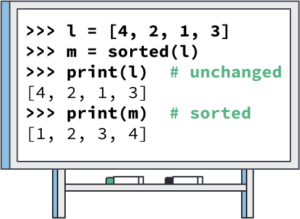Sorting Out .sort() and sorted()
Sometimes sorting a Python list can make it mysteriously disappear. This happens even to experienced Python programmers who use .sort() when they should have used sorted() instead. The differences between these two ways of sorting a list are presented in this blog.
Author: Eric Olsen, Senior DTX Services Consultant and Instructor, Ph.D.
Introduction
If you have a Python list, there are two basic ways to get it sorted. First, you can use the method built into the list object: .sort(). Second, you could use the top-level Python function sorted(). They have similar capabilities, controlled by the same keyword arguments (key and reverse). So, how do you know which one you should use in a particular place in your code?
The .sort() Method
One of the several methods built into Python list objects is .sort(). This is an in-place sort. It directly acts on the list, changing the order of items in it.
For example:
>>> l = [4, 2, 1, 3]
>>> l.sort()
>>> print(l)
[1, 2, 3, 4]Note that the call to .sort(), like a call to any Python method or function, returns a value. In the case of .sort(), the return value is the object None.
>>> m = l.sort()
>>> print(m)
NoneThis can cause problems when you are trying to save your sorted list to a new variable name (as in the example above), or when you are trying to run a for loop over a sorted list:
>>> for item in l.sort():
... print(item)
TypeError: 'NoneType' object is not iterableIt can also cause problems when trying to return a sorted list from a function:
>>> def build_list():
... x = ['c', 'a', 'd', 'b']
... return(x.sort())
>>> m = build_list()
>>> print(m)
NoneAll of these problems are the result of expecting a list’s .sort() method to return the list, rather than the None object that it actually returns. Remember that this method is used for in-place sorting only – it acts directly on the given list, replacing the current contents with new sorted contents.
The sorted() Function
In contrast, the sorted() function makes a copy of your list as it sorts it and returns that copy to you. As a result, it does two important things. First, it leaves the original list intact. Second, it hands you a sorted list object that you can store, use in a loop, or return from a function.
For example:
>>> l = [4, 2, 1, 3]
>>> m = sorted(l)
>>> print(l) # unchanged
[4, 2, 1, 3]
>>> print(m) # sorted
[1, 2, 3, 4]In each case where .sort() went wrong above, you should use sorted() instead.
Note that sorted() can also sort objects other than lists. Anything that is iterable (e.g., tuples, dictionaries, etc.) can be sorted.
Summary
Use .sort() for in-place list sorts. This operation returns a None, making it unsuitable for saving as a new list, using in loops, returning from functions, and any other context where you need a list object to continue. This in-place behavior can yield minor speed ups for larger lists compared to the sorted() approach since a copy is not being made during execution.
Use sorted() where you want to preserve the order of the original list but need a sorted list object to do some task. This generally happens when you want to save a sorted copy of your list, when you want to run a loop in a sorted order, or when you want to return a sorted list from a function.

About the Author
Eric Olsen holds a Ph.D. in history from the University of Pennsylvania, a M.S. in software engineering from Pennsylvania State University, and a B.A. in computer science from Utah State University. Eric spent three decades working in software development in a variety of fields, including atmospheric physics research, remote sensing and GIS, retail, and banking. In each of these fields, Eric focused on building software systems to automate and standardize the many repetitive, time-consuming, and unstable processes that he encountered.
About Enthought Training
Enthought Training supports scientists and engineers as they solve the problems of today while developing the creative thinking needed to realize the possibilities of digital technologies. Attend our upcoming courses and gain the knowledge and experience to tackle challenges with scientific data. Learn more here.
Related Content
The Emergence of the AI Co-Scientist
The era of the AI Co-Scientist is here. How is your organization preparing?
Understanding Surrogate Models in Scientific R&D
Surrogate models are reshaping R&D by making research faster, more cost-effective, and more sustainable.
R&D Innovation in 2025
As we step into 2025, R&D organizations are bracing for another year of rapid-pace, transformative shifts.
Revolutionizing Materials R&D with “AI Supermodels”
Learn how AI Supermodels are allowing for faster, more accurate predictions with far fewer data points.
What to Look for in a Technology Partner for R&D
In today’s competitive R&D landscape, selecting the right technology partner is one of the most critical decisions your organization can make.
Digital Transformation vs. Digital Enhancement: A Starting Decision Framework for Technology Initiatives in R&D
Leveraging advanced technology like generative AI through digital transformation (not digital enhancement) is how to get the biggest returns in scientific R&D.
Digital Transformation in Practice
There is much more to digital transformation than technology, and a holistic strategy is crucial for the journey.
Leveraging AI for More Efficient Research in BioPharma
In the rapidly-evolving landscape of drug discovery and development, traditional approaches to R&D in biopharma are no longer sufficient. Artificial intelligence (AI) continues to be a...
Utilizing LLMs Today in Industrial Materials and Chemical R&D
Leveraging large language models (LLMs) in materials science and chemical R&D isn't just a speculative venture for some AI future. There are two primary use...
Top 10 AI Concepts Every Scientific R&D Leader Should Know
R&D leaders and scientists need a working understanding of key AI concepts so they can more effectively develop future-forward data strategies and lead the charge...
